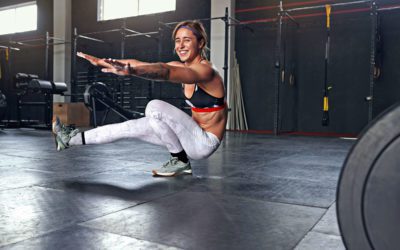How to Do Leg Extensions Without a Machine
TOPIC: Exercise guides | Strength & Conditioning
Short shorts are the new stinger tanks.
Rocking those big tree trunks with canyon deep cuts is so hot.
Leg extensions are a bodybuilding staple—they isolate your quads, the front-facing muscle group of your thighs, by flexing (bending) and extending (straightening) the knee joint. We’d argue that pretty much all professional bodybuilders with sick quad development do leg extensions. Find us one who doesn’t and win a prize or something.

Written By
Lily Frei
Lily is TrainHeroic’s Marketing Content Creator and a CF-L1 with an English background. She was a successful freelance marketer for the functional fitness industry until being scooped up by TrainHeroic. An uncommon combo of bookish, artsy word-nerd and lifelong athlete, Lily is passionately devoted to weightlifting, CrossFit, yoga, dance, and aerial acrobatics. Find her showcasing her artist-athlete hobbies on IG @lilylectric.
No machine for leg extensions? Get creative with your leg workouts
Growing massive wheels can be a real challenge for hard-gainers or people with long femurs. Squats and leg presses alone probably won’t cut it. Leg extensions are a key piece to develop your quad meat, strengthen your knee joints, and sculpt that coveted teardrop.
Thicker quads also mean stronger squats, faster sprints, higher vertical leap, and shamelessly being able to wear short shorts at the pool during summer (or only being able to wear one brand of jeans). Skinny legs are for giraffes and supermodels. Thighs that can crush a 20lb watermelon are where it’s at.
But if you don’t go to a globo gym or have access to a leg extension machine, what else can you do?
Most of the other resources out there suggest functional stuff like Bulgarian split squats, or other squat and lunge variations, but we already know those movements work your quads. They also light up the rest of your posterior chain (glutes, hamstrings), which is not what we’re going for here.
So, what are some creative ways to load and isolate your quads without a machine? We’ve got a few ideas that might get you some weird looks in the gym. (Let the normal people look. We’re here for abnormal size and strength.)
But first, a refresher on leg extension technique and principles from Kris Gethin.
Find Your Perfect Training Plan
Sometimes all you need to reach your destination on your fitness journey is an expert guide. Look no further, we've got you covered. Browse from thousands of programs for any goal and every type of athlete.
Try any programming subscription FREE for 7 days!
Leg Extension Alternatives
Since the leg extension is not a functional movement found anywhere in sports or compound exercises, it’s hard to replicate without a machine. Keep these handy options on tap as leg-day finishers or superset pieces for your compound lifts.
Also: because you don’t have an effective weight stack like a leg extension machine does, you’ll be limited on the amount of weight/resistance you can load for each of these. But that just means more reps, baby.
Banded Leg Extensions
Anchor a long band around a post or stable rack, then loop the free end around your ankle. Step out far enough so the band has tension. Using a chair, wall, or box for stability (or freestanding like this girl if you have great balance), flex and extend your knee to get the leg extension pump.
Loop a short band under your opposite foot for a similar version. There’s also this cool variation involving a squat-ish trick with a jacked New Zealand farm bro and some cows in a field.
There are a ton of different ways to set this up. The main ideas are to give your feet enough clearance off the floor and to elevate your working knee. This mimics the setup of a leg extension machine.
Grab a bench, pair of tall jerk blocks, GHD machine, or whatever else you have access to and set it in front of a rig far enough out that your band will have tension. Anchor a long band to the rig and loop it over the ankle of your working leg. Another way to set this up is to hook the band on one leg of the bench and do your extension on the opposite side.
Alternative load ideas: use ankle weights or hook the front of your foot in a kettlebell.
Put something like a foam roller or block underneath your knee for slight elevation instead of sitting it flat on the bench. This little trick makes a massive difference in the angle of your leg and the effectiveness of the movement. Flex and extend your leg as you would on a leg extension machine.
Medicine Ball Leg Extensions
Seated
Sometimes used in physical therapy practice, this version can easily be done at any CrossFit gym or at home. Find a tall seat—jerk block, reverse hyper machine, bench stacked on boxes—anything you can sit on that allows your legs to dangle freely.
Grip your medicine ball between your ankles and squeeze to hold it in place. Extend your legs out in front of you and lower back down to a slow count. The slow tempo is what maximizes the smaller amount of weight.
Pro tip: Add a foam roller, block or ab mat under your knees for elevation.
Wall sits (seriously)
If you’re skeptical about this one, then you’ve probably never experienced the ruthless agony of holding a wall-sit for minutes at a time. The quad burn is real.
Isometric holds are often underutilized for muscle hypertrophy, so don’t sleep on these!
How-To
With your back against a wall, walk your feet out a few steps, then bend your knees as though you’re sitting on an invisible chair. Make sure your legs form a 90-degree angle and your thighs are parallel to the floor. No cheating. Try to accumulate 3:00 and see just how fast your legs fatigue.
Bonus: this wild idea
Related Articles
You May Also Like...
The Best Exercises to Improve Your Sprinting Speed
Looking to get a boost in your sprinting speed? Whether you’re striving for a personal best or just getting your legs and lungs back into the habit of running fast, these exercises will give you a more efficient, stronger and speedier stride.Written Bymorey croson...
Top 6 Exercises for Managing Shoulder Injuries
After 6 years of coaching at the highest levels across multiple disciplines, the most common issues I see in my sports therapy clinic have to do with the shoulder. Statistics show us that shoulders are the most commonly injured area in many sports including CrossFit,...
How to Get Your First Pistol Squat
The single leg squat (a.k.a. pistol squat) is a challenging, advanced movement that requires single-leg strength, stability, mobility, balance, and motor control. If you are looking to get your first pistol, or just want to continue getting better at them, here is a...
The Best Exercises to Improve Your Sprinting Speed
Looking to get a boost in your sprinting speed? Whether you’re striving for a personal best or just getting your legs and lungs back into the habit of running fast, these exercises will give you a more efficient, stronger and speedier stride.Written Bymorey croson...
Top 6 Exercises for Managing Shoulder Injuries
After 6 years of coaching at the highest levels across multiple disciplines, the most common issues I see in my sports therapy clinic have to do with the shoulder. Statistics show us that shoulders are the most commonly injured area in many sports including CrossFit,...


Want more training content?
Subscribe
For Coaches
For Athletes
About
Support
Training Lab
Access the latest articles, reviews, and case studies from the top strength and conditioning minds in the TH Training Lab!
Made with love, sweat, protein isolate and hard work in Denver, CO
© 2024 TrainHeroic, Inc. All rights reserved.





